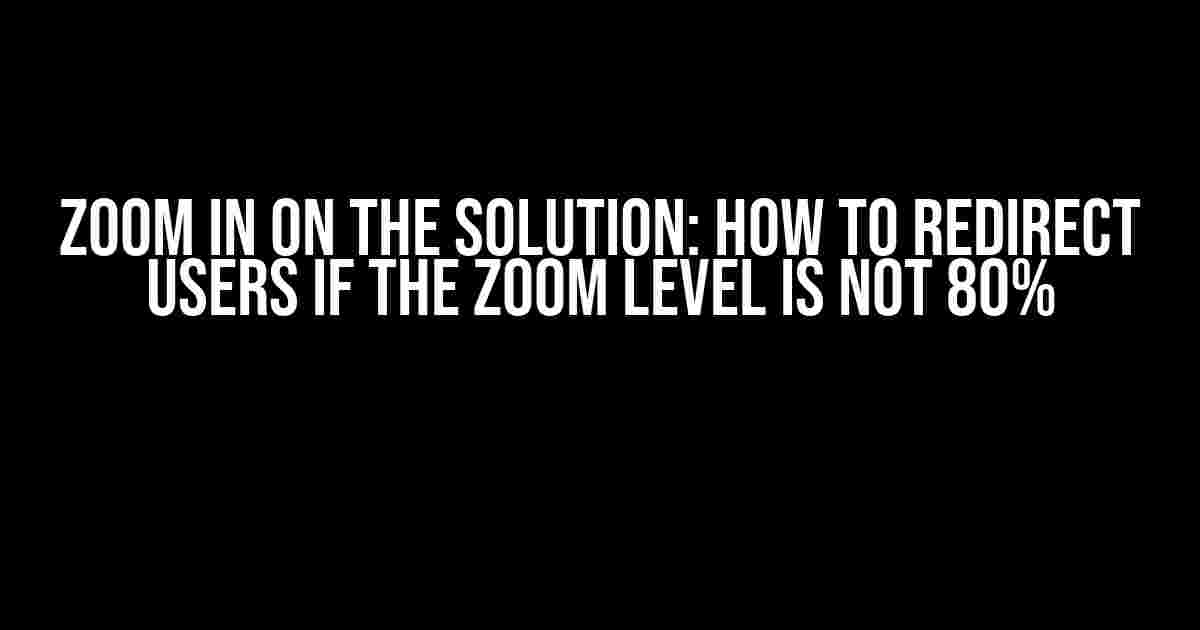Are you frustrated with users accessing your website with zoom levels that distort your carefully crafted design? Do you want to ensure that your website looks its best, even on devices with varying screen sizes and resolutions? Look no further! In this article, we’ll explore how to redirect users if the zoom level is not 80%, ensuring an optimal viewing experience for all.
Why 80% Zoom Level?
The 80% zoom level is often considered the sweet spot for website design. It provides an ideal balance between legibility and layout, allowing users to easily read and interact with your content. However, with the rise of responsive design and varying screen sizes, it’s not uncommon for users to access your website with zoom levels that are either too high or too low.
The Consequences of Inconsistent Zoom Levels
- Distorted layouts: When users access your website with an incorrect zoom level, your carefully designed layout can become distorted, making it difficult for users to navigate and find what they’re looking for.
- Text legibility: Inconsistent zoom levels can affect text legibility, making it challenging for users to read your content.
- Broken functionality: In some cases, incorrect zoom levels can even break functionality, such as hover effects, dropdown menus, and other interactive elements.
Detecting the Zoom Level
To redirect users if the zoom level is not 80%, we first need to detect the current zoom level. There are a few ways to do this, but we’ll focus on using JavaScript and the window.devicePixelRatio property.
const zoomLevel = window.devicePixelRatio * 100;This code snippet returns the current zoom level as a percentage. If the zoom level is not 80%, we can then redirect the user to a page with instructions on how to adjust their zoom level.
Redirecting Users
To redirect users if the zoom level is not 80%, we’ll use JavaScript to check the zoom level and redirect the user if it’s not within the desired range. Here’s an example code snippet:
This code snippet checks if the zoom level is not 80% and redirects the user to a page called zoom-instructions.html, where they can find instructions on how to adjust their zoom level.
Creating a Redirect Page
The redirect page should provide clear instructions on how to adjust the zoom level. Here's an example of what the page could look like:
| Browser | Zoom Adjustment Instructions |
|---|---|
| Google Chrome |
|
| Mozilla Firefox |
|
| Microsoft Edge |
|
Common Issues and Solutions
While implementing this solution, you may encounter some common issues. Here are some solutions to help you troubleshoot:
Issue: The redirect page doesn't load
Solution: Check that the redirect page is correctly linked and that the JavaScript code is executed correctly.
Issue: The zoom level detection is inaccurate
Solution: Ensure that the window.devicePixelRatio property is supported by the user's browser. You can also use alternative methods, such as the document.documentElement.offsetWidth property, to detect the zoom level.
Issue: The redirect page is not accessible on mobile devices
Solution: Ensure that the redirect page is optimized for mobile devices and that the instructions are clear and easy to follow.
Conclusion
In conclusion, redirecting users if the zoom level is not 80% can significantly improve their viewing experience. By detecting the zoom level using JavaScript and redirecting users to a page with instructions, you can ensure that your website looks its best, even on devices with varying screen sizes and resolutions. Remember to test your implementation thoroughly and troubleshoot any common issues that may arise.
With this solution, you can provide an optimal user experience, increase engagement, and boost conversions. So, what are you waiting for? Zoom in on the solution and start redirecting users today!
Happy coding!
Here are 5 Questions and Answers about "How can I make the page redirect if the zoom level is not 80%?" in HTML format:
Frequently Asked Question
Get the answers to your burning questions about redirecting pages based on zoom levels!
How can I detect the current zoom level of a user's browser?
You can use JavaScript to detect the current zoom level of a user's browser. One way to do this is by using the `window.devicePixelRatio` property, which returns the ratio of the resolution in physical pixels to the resolution in CSS pixels. For example, if the user has zoomed in to 120%, the `window.devicePixelRatio` would return 1.2.
What is the ideal zoom level for redirecting a page?
The ideal zoom level for redirecting a page depends on your specific use case, but 80% is a common threshold. This is because most browsers default to 80% zoom, so redirecting at this level ensures that users with non-standard zoom settings are accommodated.
How can I redirect a page using JavaScript?
You can use the `window.location` object to redirect a page using JavaScript. For example, `window.location.href = 'https://example.com';` would redirect the user to https://example.com. You can also use `window.location.replace()` to replace the current page in the browser's history.
Can I use CSS to redirect a page based on zoom level?
No, CSS does not provide a way to redirect a page based on zoom level. CSS is primarily used for styling and layout, while redirecting a page requires JavaScript or server-side programming. You can, however, use CSS media queries to apply different styles based on zoom level.
Are there any accessibility concerns when redirecting a page based on zoom level?
Yes, there are accessibility concerns when redirecting a page based on zoom level. Users with disabilities may rely on custom zoom settings to access your content, and redirecting them could disrupt their experience. Be sure to provide alternative access to the redirected content and consider using more inclusive approaches to accommodating different zoom levels.
